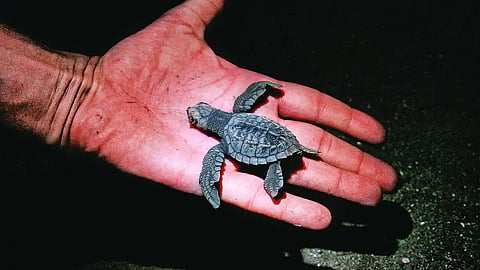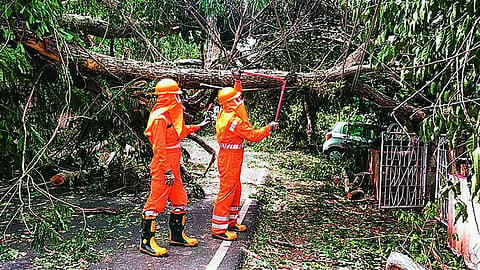Swim, wade, surf off Goa’s beaches as much as you want for now.? By 2050, sea level rise (SLR) is expected to inundate 40 per cent of Goa’s low-lying areas, ravaging the state’s popular beaches by draining the sand along its 105-km coastline. Beaches across the stretch of the state like Keri, which lies at the tip of North Goa and Talpona beach at the state’s southern tail, have already been partly gobbled by rising sea waters.
Goa's Battle Against The Ills Of Global Warming And Indiscrete Concretisation
By 2050, sea level rise is expected to inundate 40 per cent of Goa’s low-lying areas, ravaging the state’s popular beaches by draining the sand along its 105-km coastline.
The climate change-induced phen-o-menon of SLR is a global scourge and is destined to disintegrate large tracts of Goa’s beaches over time. But a greater danger lies ahead; a combo effect of cyclones, extremely heavy rainfall and SLR conjoining to produce catastrophic impacts. A few events in recent years have been starkly indicative—triggering unprecedented flooding, increased erosion on some beaches and even in estuarine areas in Goa.
ALSO READ: Tears Of The Mermaid: The Melancholy Of Goa
A couple of these events were triggered by very severe cyclonic storms—Cyclone Vayu in June 2020 and Cyclone Tauktae in May 2021—two of the 18 cyclones that formed in Bay of Bengal and Arabian Sea in 2019, 2020 and 2021. For instance, at Galgibaga beach in South Goa, a popular Olive Ridley turtle nesting site, high waves during the very severe cyclonic storm, Cyclone Vayu, truncated a sandbar that had formed over decades or more, in just a few hours, blocking Galgibaga’s river mouth. The sandbar (spit) had forced the river to divert its course to the sea southward by a few hundred metres.

The extremely severe Cyclone Tauktae that followed in mid-May 2021 ripped open the remnant of the spit on the beach, uprooting rows of casuarina trees and directly connecting the river to the sea. Panic spread in upstream areas as the water level rose significantly. Tourism accounts for nearly a quarter of the state’s Gross Domestic Product, and especially in view of the grinding halt of the state’s mining sector over the last few years, the hot sands which line Goa’s beaches are worth their weight in gold for the state’s fragile economy.
The state water resources department (WRD) recently roped in the Chennai-based National Institute of Ocean Technology (NIOT) to study the sea bathymetry—a study of ocean beds to analyse the damage to beaches. “We are waiting for the NIOT findings by the year-end, which will be critical to undertake anti-erosion measures… In the meantime, the Central Water and Power Research Station (CWPRS) has advised us to monitor the shoreline and the affected stretches for some time,” according to Pramod Badami, the department’s chief engineer.
NIOT is the process of studying decades-old data related to rainfall, river discharge and other aspects, while the Pune-based CWPRS tasked by the Goa government for erosion management, has apparently learnt some hard lessons from utilisation of hard solutions in the past, like setting up flexible gabion walls (cages packed with rocks or concrete for soil stabilisation) and concrete tetrapod barriers, and has now sensibly advised a wait and watch approach.
Over a decade-and-a-half,? the WRD pursued two projects as part of its mitigation measures at Keri. The first one was a 1.6-km-long gabion seawall at a cost of Rs 4.2 crore. Tidal action, however, dismantled the protection wall in a few years. WRD then came up with another hard solution to counter the sea’s fury—a tetrapod wall. Concrete tetrapods have been found to be more effective in some places like Mumbai, albeit along fixed stretches of coastline.

In Keri, the installation work of the 1,200 huge tetrapods and 2,000 blocks from 2012 took several years. But the seemingly impenetrable 650-metre wall raised at a cost of Rs 11.4 crore started collapsing, as warned by environmentalists, within a short period. With waves chipping away at the wall’s base, the sand was sucked into the sea, destabilising the barrier. It continues to sink, pulling in the tetrapods deeper into the sand. “Hard solutions are a waste of money. Research globally has shown clearly that seawalls and revetments have destroyed beaches, reduced their width or simply sucked away all the sand. In Kerala, 60 per cent of the coast is fixed by seawalls but despite huge costs, the beaches have been drained of sand,” says Antonio Mascarenhas, a former scientist with the National Institute of Oceanography (NIO).
Beach erosion is not a new concern, being noticed as early as 1932, and randomly in later years, but restoration, unlike in the past, had been occurring naturally. What is a matter of concern is the pace and intensity with which the phenomenon has whittled away Goa’s coastline in recent years. There is a pandemic of sorts in some other key stretches where the sea is progressively swallowing more and more land. The signs are there for all to see.
The quiet and panoramic Keri beach, on the Tiracol rivermouth and the equally scenic beach of Nerul, often called Coco beach, on the northern banks of the Mandovi rivermouth, are among the worst-affected spots in north Goa. In the south, Talpona beach has been showing the impacts of similar devastation. The wave action has seen the sea claim more territory at Keri and Nerul, stripping the luxuriant sandy bed in the surf zone and uprooting rows of casuarina and coconut trees on both beaches. At Nerul beach alone, devastating erosion that started around 2005 has swallowed at least 1,000 sq m of the beach.
The state WRD has also noticed more erosion in recent years at Vithalwado in Morjim, a popular tourist enclave in north Goa, Velsao--Pale, Arossim, Colamb and Colamb-Patnem in south Goa. Rapid growth of tourism and construction activities along beaches in an unplanned, piecemeal pattern that destroyed sand dunes and local ecosystems are being blamed partly for the present mess. Concretisation of the coastal belt creates heat islands along the shoreline. The bulk of the heat is absorbed by oceans, which in turn has led to an increase in sea level by two-thirds. An increase by another one-third is caused by meltwater from polar ice-sheets, according to experts.
The good news in the bleak scenario is a recent finding by the National Centre for Coastal Research (NCCR) that 20 per cent of the beaches are showing evidence of accretion. A Goan geographer, F.M. Nadaf, has corroborated the research institute’s findings on the ground.? “After a year, a part of the sandbar is showing signs of accretion, which over a period of time may restore it. Coastal vegetation growing on it is binding the accreted portion,” says Nadaf. Mascarenhas also recommends measures like sand nourishment to counter the threat of erosion. “Sand nourishment or replenishment at eroded spots is a feasible option. Eco-restoration of degraded sand dunes and creation of artificial sand dunes will help towards mitigation, while sand dunes should be assiduously fenced off for protection,” he adds.
It is only a fitting irony that the sands of Goa, if cared for, may well be the difference in the state’s battle against time in the age of accelerated climate change.
(This appeared in the Print version as 'Shifting Sands')
(Views expressed are personal)
Paul Fernandes is a freelance journalist who writes on heritage and environment